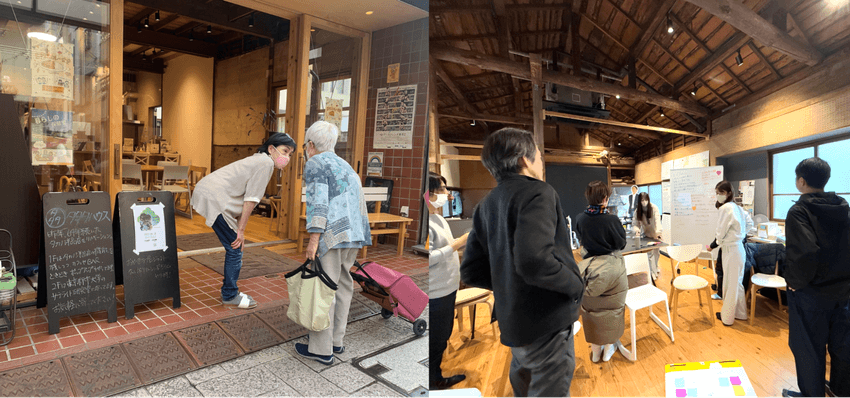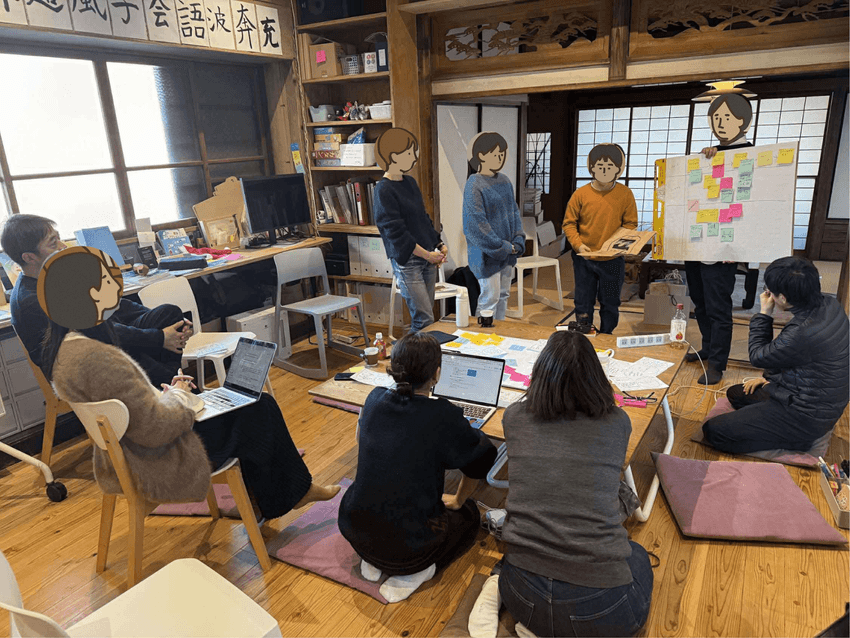Hi there! I’m Koki Kusano, conducting service design research at R4D.
In this article, I’d like to introduce an example of Mercari R4D Lab’s networking activities, in which we collaborated with Oyamachi Living Lab, located in the Oyamadai area of Setagaya Ward, Tokyo. This collaboration came about as part of our research to design services built for a world that circulates all forms of value.
The concept of “playing to the fullest” is one of our focus topics, for which we engage in related research and initiatives. Here, I will introduce an overview of this topic, what happened when we tested the topic in the Oyamachi Living Lab project, and what we find fascinating about this research.
What does “playing to the fullest” mean?
“Playing to the fullest” is an important concept in a new method of conducting research and design from a personal perspective, which we call “playful active mastery research” (PAMR). Let’s break down the definition into three keywords: “playful,” “active,” and “mastery.”
Playful refers to an experimental attitude of enjoying and accepting things that may seem silly or just for fun, without fearing failure. Instead of seeking a “correct” answer, we aim to make new discoveries while enjoying trial and error. We prioritize participants’ feelings of enjoyment and interest in what they are doing.
Active positions participants not as passive recipients, but as core figures who play to the fullest themselves. Instead of merely answering questions prepared by researchers or facilitators, participants articulate what they want to try, think of solutions, and take action.
Mastery means reinterpreting and mastering existing tools and systems in our own way. Rather than coming up with a new service from scratch, participants creatively utilize familiar platforms and apps, adapting them to fit their purposes. Sometimes, figuring out how to master them can lead to the discovery of new features or services.
What’s interesting about the approach of playing to the fullest?
PAMR is interesting because participants don’t just express opinions or come up with ideas, but also articulate problems, create solutions, and actually try the solutions for themselves. The role of the facilitator is to prepare a playful environment and have fun together with the participants. I believe that this unique relationship creates a perfect environment for practical ideas.
For example, we often perceive marketplace apps as platforms for buying and selling between individuals, but in this collaboration with the Oyamachi Living Lab, participants thought, “Wouldn’t it be more enjoyable to share stories related to items with other people in the local community?” and actually tried it out at an event.
Below, I will introduce that example in detail.
Example of playing to the fullest
In this project, we tried PAMR at the Oyamachi Living Lab in Oyamadai, an area of Setagaya Ward, Tokyo, for one month in early 2025. The participants were 8 local residents (6 women and 2 men) of a variety of ages and professions.
Day 1 began with each participant sharing their experiences with marketplace apps. Some examples: “I make a lot of accessories as a hobby, but they just sit at home,” “I want to sell my art, but I don’t want to set a price myself or hold an auction,” and “While anonymity provides a sense of security, for some items, I would feel more comfortable knowing who the other person is.”
Based on this discussion, the participants began to brainstorm ideas, with opinions ranging from “Sharing these experiences is interesting in and of itself” to “It would be great if the local community could collaborate on the listing process.” At this time, we emphasized brainstorming ideas from the perspective of what would be fun for you yourself to try rather than what would be beneficial to others or what you want other people to do.
Day 2 focused on fleshing out the ideas that emerged on day 1. We continued to be conscious of creating activities as not for someone else’s sake or for someone else to do, but things participants want to do for themselves.
As a result, we combined the ideas of “bringing items that participants thought about listing on marketplace apps but couldn’t, and sharing the stories of those items while exchanging them” and “everyone listing and packing items together,” leading to the creation of a new project called “Merkame” that emphasizes enjoying things at one’s own pace. Then, the participants took the initiative and decided to actually try this out as day 2.5.
 Merkame-kun (a character created by a local designer involved in this initiative)
Merkame-kun (a character created by a local designer involved in this initiative)
On day 2.5, participants brought items they had thought about listing on marketplace apps but couldn’t, and shared stories related to those items. For example, one participant brought something they had received as a gift; another brought handmade accessories; another brought a wallet full of memories; yet another brought a game their children no longer played. As the stories were shared, these items that would typically be judged based on whether they could be sold resonated with participants through their narratives, garnering more interest and helping the items find new homes among the participants. (I’ll explain the Merkame initiative in more detail in the second part of this article.)
On day 3, we looked back on how the participants felt about day 2.5. We received comments such as “The stories behind each item resonated with me and made me want items that I wouldn’t normally consider buying on Mercari,” “Seeing the item and hearing the owner tell their story at the same time gave me a sense of that person’s character; it was really fun,” and “It made me interested in listing my item myself if no one took it home.” Additionally, some of the participants even asked when we could hold the next event.
What we saw from “playing to the fullest”
I believe that we saw the following three signs from PAMR as a new design research method.
Trying things for yourself
In typical research, participants only express their requests to the service provider, but this initiative was unique in that participants tried out their ideas themselves. As a result, they were able to convey to others the reality of what it was like when they actually tried it themselves, such as what went well. During the subsequent event when we gave a report on our activities, the participants showed a willingness to continue collaborating with us.
Realizing unexpected value by yourself
We observed how participants reinterpreted an existing service in their own way and discovered new ways to use it. For example, there were new realizations that sharing stories about items that the owner didn’t list allows for a deeper understanding of a person and that the act of hearing those stories is interesting in itself.
Forming and renewing interpersonal relationships
This project was conducted at the Oyamachi Living Lab, a place that connects people in the local community. Within this setting, as we tackled the shared theme, we observed relationships between participants being formed and renewed. This seems to be related to the fact that participants were able to see unexpected sides of each other by talking about personal experiences with Mercari and playing to the fullest within one’s own local community.
Steps to start “playing to the fullest”
The “playing to the fullest” approach is a casual approach that can be started at the grassroots level. Here are some simple steps.
Set a familiar theme that all participants can share
In this project, we used Mercari as a theme, but it can be done with other themes as well. Start by asking participants to share their current situation (how they are using it now, and what they find fun/not fun) and then lead discussion to brainstorming ideas for what would make it more fun for them.
Have participants share their personal experiences before brainstorming
The important thing is for participants to think from their own perspective. Setting aside what others might think and sharing what you are interested in, what you like, and how you would feel based on your own experiences can lead to unique perspectives and ideas naturally coming to mind. You might even find that others share opinions or experiences that you thought no one else had.
Try it for fun and enjoy failure
Make sure that participants are having fun first and foremost. Instead of aiming for perfection, continuously conduct small experiments. Even if it doesn’t go well, the act of experimenting itself is fun. In our experiment, we emphasized the idea of learning from trying.
Share the rules
Finally, I recommend creating and sharing rules among participants. For example, in this project of playing to the fullest with Mercari, we established four basic rules. In particular, I think it was effective to include rules encouraging participants to consider ideas that would be good for other people as well—especially because we started by focusing on thinking from their own perspective.
If you found this interesting, I hope you’ll consider trying it out for yourself. I’d also be happy to answer any questions you may have and provide more details for those interested in holding a similar event in their own community.
In conclusion
In this article, I introduced the PAMR approach of “playing to the fullest” from a personal perspective. In the future, I hope to combine PAMR with the more conventional method of experts investigating residents’ needs and proposing solutions in order to create better services and aim for a society where those services help build better relationships between people.
In the second half of this article, I will go into more detail about Merkame, the specific activity that emerged from this experiment with PAMR. Keep reading to learn more about the moment when the value of an item changes due to stories associated with it and the possibilities of a new sharing culture.




